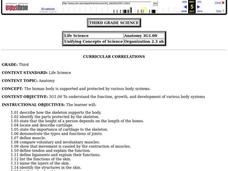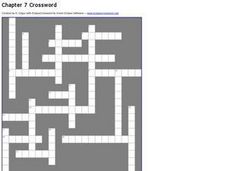Curated OER
Keeping Your Heart in Good Shape: What are the Benefits? - Biology Teaching Thesis
Students name the main parts of the heart and what events occur there. They write a reaction that contains complete sentences, and uses proper spelling and grammar, after viewing a video. Students define the following terms: contraction,...
Curated OER
Sensory and Motor Mechanisms
Advanced biology pupils name the function of each individual structure on figures of the eye and the ear. They describe the purpose of the skeleton and how it works with the muscles to create movement. Finally, they label a large diagram...
Curated OER
Muscle Tissue
In this muscle tissue worksheet, students match 10 terms with their definitions, answer 12 multiple choice questions, fill in 25 blanks with the appropriate terms and answer 4 questions about topics related to muscle tissue. Students...
Curated OER
Dunking Duckies - Endless Expansion And Contraction
Students use inquiry to explore how their dunking duckie bobs up and down. In this states of matter instructional activity, the teacher guides the class towards discovering how the dunking duckies continue to bob up and down for days...
Curated OER
The Animal Body and How it Moves
Spark interest in the body structure of vertebrates with this comprehensive and colorful learning exercise. Your biology class will explore the levels of organization, primary tissue types, and the main organ systems. Finally, they hone...
Curated OER
Can You Make a Muscle?
Why are muscles important? Third graders study the different kinds and functions of muscles in the human body. After drawing arrows in an illustration to indicate where a muscle contraction would occur, they do their own experiment about...
Koshland Science Museum
Infectious Disease: Evolving Challenges to Human Health High School Virtual Field Trip
Understanding the science of the spread of infectious diseases is the first step in controlling them. Learners begin by researching the factors that affect the contraction and spread of these diseases and the challenges communities face...
Curated OER
21st Century Medicine: Nerves of Steel
Students model a sarcomere's action, they gain a kinesthetic and visual understanding of muscle contraction. They use this exercise stimulates the production of myosin and actin. Students use two colors of clay, make a "sandwich" of...
Curated OER
Muscular System
In this muscular system worksheet, students define related terms of the muscular system, they identify types of muscles, they order the events of muscle contraction and given a clue about structures and function of the muscular system...
Curated OER
Pump It Up!
Learners design a pumping device that will effectively pump fluid through a model "cardiovascular system." They explore the effects of too much and too little pressure on a circulatory system.
Curated OER
Scale Model of the Solar System
Young scientists gain a better understanding of space, the solar system and its vastness by creating a scale model. Students first need to calculate the distance between each of the nine planets according to the size of their scale. This...
Curated OER
Endocrine Review Sheet
Starting with a diagram of the kidneys and urinary tract of the human, this sheet has questions about excretion, blood concentrations of hormones, gland feedback mechanisms and the effects of some hormones.
Curated OER
Exercise and the Human Heart
Interpret data and learn about the human heart in one activity! After learning about the way blood flows in the body, fifth graders answer two questions about a graph displaying pulse rate. They then take their own pulses to find the...
University of Minnesota
Homeostasis of Thermoregulation
Whether you're battling the flu or trying to warm up on a chilly day, your body's ability to react to temperature change is fascinating! Anatomy scholars discover the fantastic feedback loops that control body temperature in a rigorous...
Curated OER
MuscleMania
Middle schoolers learn three different types of muscles. By building a model of the arm, they learn its basic anatomy and how muscles function in relationship to bones. They perform an experiment on the relationship between muscle size...
Curated OER
PhysioEx: Frog Cardiovascular Physiology
In this science worksheet, students are guided through a computer simulation of a frog dissection in which the heart is kept beating. Students test each of seven solutions by introducing it into the simulated heart. Students collect...
Curated OER
From One End to the Other
Seventh graders trace a piece of food through the digestive system. They describe the functions of the mouth, esophagus, stomach, etc.
Alabama Learning Exchange
Animal Classification
Present information about the classification of animals. After participating in the teacher-led discussion about scientific names, small groups devise their own way of classifying everyday objects present in the classroom, developing...
Curated OER
Skeletal System
Third graders describe and identify the parts of the skeleton and how they support the body. They observe two chicken bones that have been soaked in vinegar for 5 - 7 days. They observe the bone's appearance after it has been removed...
Curated OER
From One End to the Other
Seventh graders trace a piece of food through the alimentary canal and differentiate between mechanical and chemical digestion in several different hands-on activities related to digestion.
Curated OER
THE WONDERFUL WATER CYCLE
Learners are introduced to the processes of evaporation and condensation as they observe physical changes in water. They observe how matter changes from a solid to a liquid state. Students are explained that steam is water in its gaseous...
Curated OER
Investigation 3 - Weathering
Fourth graders study 4 types of weather processes: wind, running water, plant growth, and freezing water. They explain how the processes of weathering and erosion change and move materials that become soil. They draw diagrams...
Curated OER
Homeostasis and Feedback Worksheet
In this homeostasis worksheet, students sketch and label graphs showing homeostasis for the following conditions: blood glucose, temperature, systolic blood pressure, and blood pH. Students define and give an example of positive...
Curated OER
Digestive System Crossword
In this digestive system worksheet, learners complete a crossword puzzle by figuring out the vocabulary words associated with the 21 clues given.
Other popular searches
- Alphabetizing Contractions
- List of Contractions
- Apostrophe Contractions
- Contractions and Possessives
- Pronoun Contractions
- Contractions Worksheet
- Contractions With Pronouns
- Writing Contractions
- Contractions With Not
- Lesson Plans on Contractions
- List of Contractions Words
- Missing Words in Contractions

























